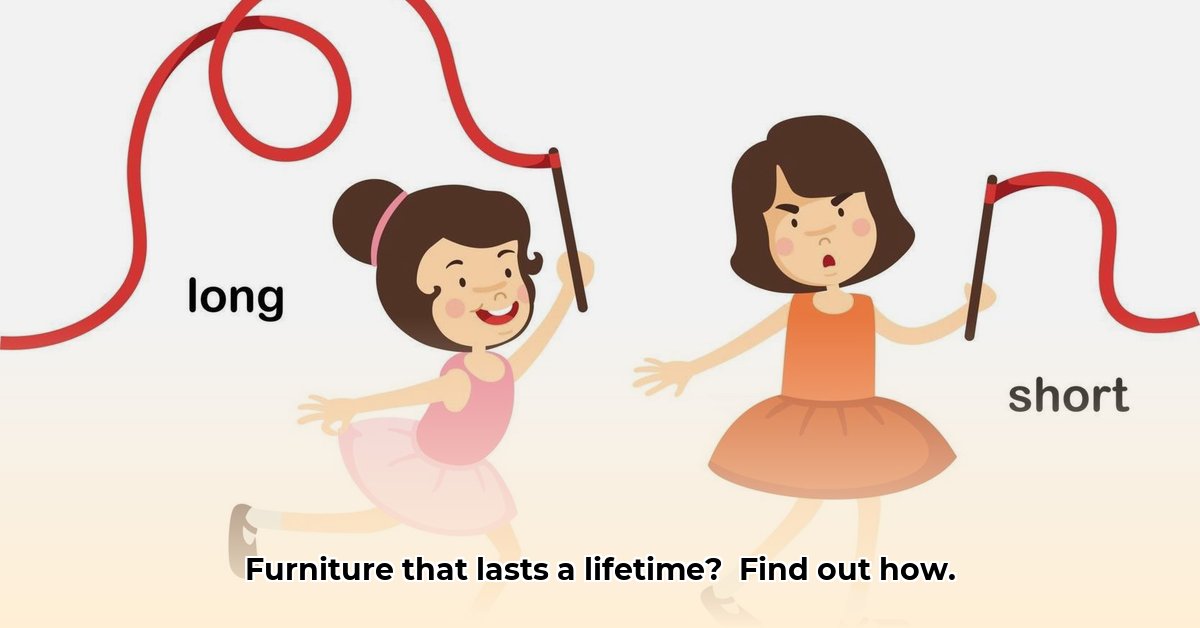Want furniture that lasts? Forget constantly replacing worn-out sofas and wobbly chairs! This guide shows you how to choose pieces built to stand the test of time. We’ll cover everything from picking the right materials (solid wood is your best friend, we’ll tell you why!) to understanding what makes a strong frame. Learn the secrets to keeping your furniture looking great, and discover how to spot timeless designs that won’t go out of style next year. Let’s build a home filled with furniture you’ll love for decades to come – it’s easier than you think! For more buying advice, check out this helpful resource on [furniture quality](https://www.wavesold.com/is-american-furniture-warehouse-good-quality).
Long-Lasting Furniture Recommendations: Building a Legacy, One Piece at a Time
Investing in furniture is a big decision. It’s not just about buying something; it’s about adding pieces to your life that you’ll cherish for years, even decades. This guide will help you choose furniture that truly stands the test of time, saving you money and headaches in the long run. But what key aspects should you consider for furniture investment? The lifespan of your furniture actually depends on three key areas, as we’ll see.
The Secrets to Furniture That Lasts: It’s More Than Just Looks
Building furniture that endures isn’t magic; it’s about smart choices and understanding what makes a piece strong and durable. Think of it like building a house – you wouldn’t use flimsy materials, would you? It’s the same with your furniture. Quality materials and construction are essential.
The lifespan of your furniture depends on three key areas:
-
Material Matters: Solid hardwood, like oak, maple, or cherry, is the gold standard. These woods are naturally strong and resistant to damage. Particleboard and MDF (medium-density fibreboard), while cheaper, are much less durable and are likely to show wear and tear much quicker. Is solid hardwood really that superior? Yes, think of it like comparing a sturdy oak tree to a flimsy cardboard box. Solid wood furniture boasts a natural resilience, capable of withstanding decades of use and maintaining its structural integrity, while particleboard tends to sag, chip, and degrade over time.
-
Strong Joints Are Key: Pay close attention to how the pieces are joined together. Look for strong techniques like dovetail, mortise and tenon, or dowel joints. These are like the strong bones of a sturdy skeleton, holding everything together firmly. Weak joints often result in wobbly pieces that fall apart easily. Corner blocks, screwed and glued into place, also add significant stability. Avoiding staples and nails in favor of these stronger joinery methods ensures your furniture remains solid for years.
-
The Protective Power of Finishes: A high-quality finish acts like armor for your furniture, protecting it from scratches, spills, and everyday wear and tear. Catalyzed conversion varnish is a particularly durable option, offering resistance to heat, moisture, and many common household chemicals. Look for multi-step finishing processes that include sanding, staining, sealing, and top coating for maximum protection and aesthetic appeal. A good finish is an investment that pays off in the long run which helps keep it looking its best for years to come.
Choosing Furniture Built to Last: A Step-by-Step Guide
Finding quality, long-lasting furniture takes some effort, but it’s worth it. What key factors should you consider for longevity? Follow these steps to make informed decisions:
- Define Your Style: Choose classic pieces over trendy ones. Timeless styles tend to age better and remain relevant for longer periods. Something that looks good today will still likely look good in 10 or 20 years. Consider styles like mid-century modern, traditional, or Shaker, which have proven their enduring appeal.
- Think About How You’ll Use It: What will the furniture be used for? A sofa in a high-traffic living room will experience different types of wear than a dining chair rarely used. This impacts the type of material and construction you should consider. For instance, a frequently used dining table needs a heat-resistant and scratch-proof finish.
- Investigate the Materials: Prioritize solid wood whenever possible. The upfront cost might be higher, but its longevity will likely save you money in the long run by avoiding frequent replacements. When solid wood isn’t feasible, look for high-quality plywood with a hardwood veneer, which offers better durability than particleboard.
- Inspect the Joinery: Carefully examine the joints. Are they sturdy and well-made? Do they look strong enough to withstand daily use? Give the piece a gentle push or shake to test for wobbling or looseness. Strong, interlocking connections are the hallmark of quality furniture construction.
- Evaluate the Finish: A smooth, even finish isn’t just about looks; it’s crucial for protecting the wood from damage. Check for imperfections like bubbles, streaks, or uneven coverage. A well-applied finish is an important element of a piece’s longevity.
- Read Reviews: Check out what other buyers have to say. Online reviews often provide valuable insight into a piece’s durability, longevity and potential issues that might arise. Pay attention to reviews that mention long-term use and any problems that developed over time.
- Check the Warranty: A longer warranty (5 years or more) often shows that the manufacturer stands behind the quality of their product. Carefully read the warranty terms to understand what is covered and for how long.
Caring for Your Investment: Simple Maintenance for a Longer Life
Even the toughest furniture benefits from some care and attention. Think of this as preventative maintenance – taking care of minor issues before they become major problems. So, what simple routine maintenance can you implement to extend your furniture’s life?
- Regular Cleaning: Dust and clean your furniture regularly using appropriate cleaning methods. Avoid harsh chemicals that can damage the finish. Use a soft cloth and a pH-neutral cleaner specifically designed for wood furniture.
- Protective Measures: Use coasters, placemats and furniture covers to protect surfaces from scratches, spills, and other damage. Consider using furniture pads under the legs of chairs and tables to prevent scratching floors.
- Address Minor Issues Promptly: A tiny scratch ignored can quickly turn into a bigger problem. Fixing minor damage early prevents more serious (and costly) repairs later. Use touch-up markers or repair kits to address scratches and chips as soon as they appear.
The Sustainability Angle: Eco-Friendly Choices
Many consumers are looking for furniture that reflects their values as well as their style. Consider brands that source materials sustainably and employ responsible manufacturing practices. Reclaimed wood, for example, is an environmentally friendly option that also adds unique character to furniture. Look for certifications like FSC (Forest Stewardship Council) to ensure wood is sourced from well-managed forests.
The “Timeless Design” Debate: What Does It Really Mean?
The idea of “timeless design” is a matter of personal preference. However, choosing styles that you’ll still love in several years is a great way to avoid trends that quickly become outdated. Consider the overall architecture and style of your home when selecting furniture. Investing in versatile pieces that can adapt to changing tastes and décor is key. This also reduces waste, an important factor in today’s environmentally conscious world.
The Bottom Line: Investing in Quality Pays Off
Choosing long-lasting furniture may seem like a larger investment upfront, but the benefits are significant. This includes not only the improved longevity meaning you are less likely to need replacements but also the environmental aspect of having less furniture waste. Additionally, high-quality furniture often retains its value better, making it a worthwhile investment in the long run. You’re investing in quality, durability, and a piece that will be part of your home and life for years to come.
How to Compare Different Furniture Wood Types for Longevity
Key Takeaways:
- Hardwood furniture generally outlasts softwood and engineered wood options.
- Wood density and grain directly impact durability.
- Proper finishing and regular maintenance extend furniture lifespan significantly.
- Consider the intended use and environment when selecting wood.
- Sustainable sourcing is crucial for responsible furniture choices.
Understanding Wood Types: A Foundation for Longevity
So, you’re investing in furniture – great! But how do you ensure it lasts? The secret often lies in the wood itself. How to compare different furniture wood types for longevity starts with understanding their inherent qualities. Hardwoods, like oak or maple, boast denser grains, making them naturally resistant to dents and scratches. Softwoods, such as pine, are softer and more prone to damage – perfect for less demanding pieces, but not a dining table at a busy household. Engineered woods offer affordability, but often compromise on long-term durability. Think of solid wood as an investment, offering resistance to wear and time, while engineered wood serves as a more cost-effective, short-term solution.
Comparing Hardness and Grain: The Durability Equation
Let’s dive into specifics. Imagine hardwood as a tightly woven tapestry—strong and resilient. Softwood’s structure is more loosely knit. This density difference significantly impacts furniture’s lifespan. A denser wood resists scratching, denting, and wear better – consider it a crucial factor in how to compare different furniture wood types for longevity. Grain patterns also matter. Tight, straight grain resists warping and splitting better than irregular grain. Look for quarter-sawn wood, known for its exceptional stability and resistance to warping.
Examining Key Wood Properties: A Practical Guide
Here’s a simplified comparison:
| Wood Type | Density | Scratch
- Stove Backsplash Design: Ideas to Elevate Your Kitchen Style - December 26, 2025
- Backsplash For Cooktop: Stylish Ideas To Protect and Enhance - December 25, 2025
- Stove Backsplash Ideas: Find Your Perfect Kitchen Style - December 24, 2025










